
| innig.netMusicIn the HandsRecording MethodMicrophones |
I use a rather unorthodox miking strategy: an unmatched pair of mics, placed very close, on completely different parts of the instrument facing completely different directions, lid barely open. It's a strategy I came to after long hours of experimentation with many different brands of mic in many different locations. And really, although much detail about what I came up with follows here, my real advice to others is this:
Experiment, experiment, experiment.
Every instrument, every room, and every taste is different, so my setup may not work for you. Try lots of mics before you buy. (If an audio dealer won't let you take a mic home overnight and give it a whirl, they're not worth dealing with.) Experiment with positioning. (Placement is huge. A $200 mic in the right place can sound worlds better than a $3000 mic in the wrong one.) Be methodical, daring, and extremely persistent.
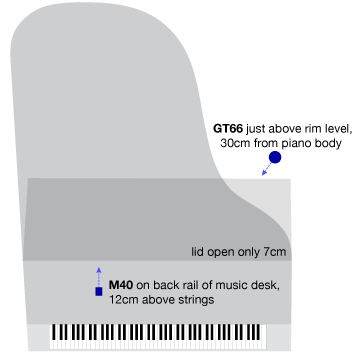
If you can find somebody with excellent ears and a knowledge of audio technology to help you experiment, it makes all the difference in the world. I had the great luck of finding several such people, Matthew Smith, Mike Olson, and Greg Reierson, whose help has been invalvuable.
That said, here's what my own experiments lead me to. A diagram is at right.
There is a huge variety of approaches to recording piano, and mine is a bit unusual. (Typical techniques look more like this.) The thing is, I often dislike the results of the usual techniques. Even many very high-quality piano recordings from reputable big-name studios sound terrible to my ears. They just don't capture the lush, massive, enveloping sound world of an actual piano. In particular:
The root of many of my complaints is the dominant traditional aesthetic of classical music recording: reproduce the concert hall. The thing is, recordings aren't live performances — the most successful art embraces its medium, and recordings should work as recordings, not as imitation concerts.
Yet even leaving that aside, the concert hall isn't the thing to reproduce. The music I play — Chopin, Brahms, Bach, Schumann, Beethoven — is made not for the modern concert hall, but for more intimate spaces. (Piano concerti are meant for large halls, and composers write very differently for the piano in that setting!) This music is meant to be heard close up, not from row 30 of a space that seats 5000. So, at best, a traditional classical recording is a good imitation of the wrong live experience.
I'm not necessarily after a recorded sound that reproduces the live sound of my piano — but it does need to capture the intimacy of the space, and the powerful, enveloping quality of a piano up close. My goal in recording is not to reproduce any live experience, but to create a whole new experience in which the music's nuances, its shapes, its essential spirit are alive and immediate. It should sound good from the inside.
OK, I am done with the complaining and philosophizing. Here are the details of how I create the recorded sound I like.
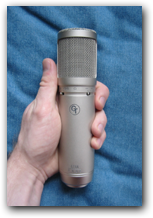
The first mic I use is a Groove Tubes GT66 large-diaphragm condenser (now apparently reincarnated as the Sterling Audio ST66). It captures the sparkling quality of my piano I was praising on the previous page, and does wonderful things for the imaging. (Oddly, it almost seemed to create a three-dimensional image when I made mono recordings with it during testing.)

The mic sits about 30cm away from the piano body, right in the "bend" of the instrument. I found that, both to my ears and in recording tests, there is a sweet spot extending outward about a meter from the bend. I experimented with different distances in that sweet spot, and liked the increasing presence and energy as the mic got closer — but found that getting any closer than this quickly bogged the sound down in proximity effect. At right are two top-down shots showing the position, one with the lid down (as it actually is during recording), and the second with the lid up to better illustrate the positioning.
The GT66 is a cardioid (that is, directional) microphone, and I found that pointing it in different directions made a tremendous difference. It points roughly toward middle C's tuning peg. Turning it more to the left emphasizes the treble, and more to the right emphasizes the bass.
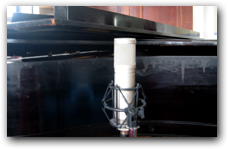
The microphone peers just over the edge of the rim of the instrument. I don't have the lid open far (more on this later), and I have the actual condensor disc of the mic centered on that narrow opening. I found that even minor departures from the opening muffled the sound.
In my tests, the less-expensive GT55 gave a very similar (and almost as pleasing) sound. The Rode NTK was also a promising contendor, with a sound that really captured the singing part of the piano, but was somehow a bit off the true sound ("nasal" was how Matthew put it). The GT66 together with the NTK was a promising combination — one I almost went with, before a very unusual dark horse entered the picture.
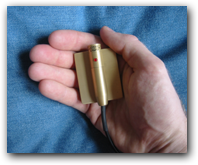
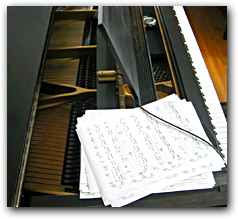

That dark horse is the Applied Microphone Technology M40 boundary mic, a tiny little fellow whose manufacturer apparently designed it specifically for piano. It has an incredibly natural sound — just sitting around in the room, it seems to capture the actual character of all the sounds it picks up, piano included. They recommend placing it on the plate, toward the end of the strings (as in their publicity photo). I tried it that way, and found it impossibly muddy with the lid low, but decent enough with the lid up all the way.
I also tried it sitting on the rim (promising, but ultimately weird), and underneath the piano, about 40cm below the soundboard, sitting on top the accordion case (which was surprisingly good). But the location that gave the best results — much to my surprise! — was sitting on the rear ledge of the music desk.
This presents a problem if you want to try this setup with a different piano: music desks are all shaped differently, and don't always present a similar home for the mic. Experimentation thus reigns surpreme. It produces a similar sound, if not quite as nice, sitting on the side of the music desk (where the sheet music is in the photo). I also tried taping it to the back of the music desk pointing in various directions, without much luck.

In this position, it sits parallel to and about 12cm above the strings, pointing straight back into the long end of the piano. It captures that big, warm core of the sound that's missing for me in most recordings.
Sitting over the bass strings, it does pick up just slightly more bass than treble — but it's surprisingly little more, and this is largely balanced by the GT66's positioning and bright character. Still, it needs a bit of correction in the mastering phase. The two of them together in this configuration hint at the spatial experience of sitting at the keyboard: low left, right high. It's not a very pronounced effect, but it is sometimes there if you listen for it.
One observation from my experiments bears special mention: the position of the lid makes a tremendous difference in the sound of the recording. This seems an obvious statement, but for some reason, recording engineers tend to take it for granted that the lid should be propped all the way.
I tried a series of recordings with just the GT66, in its current position, and a variety of different lid heights. With the lid completely shut, the sound is a muddy mess (no surprise). An opening of even just a couple of centimeters makes a tremendous difference; as the lid opens more, the muddiness dissipates. And — this is where it gets interesting — the sound keeps on changing in that direction as the lid opens more and more, becoming thinner and thinner until, at full stick, it has that anemic and brassy sound that I dislike so much.
My piano sounds best live with the lid open 20-30cm (it's a small room), but I found the recorded sound best with an opening of only 7-16cm.
Here's my theory, formed with my rather rudimentary understanding of acoustics: when the lid is open all the way, the sound dissipates in all directions, and the mic only gets a thin little slice of it direct from the instrument. What does reach the mic is either coming straight off the soundboard with no reflections at all, or is arriving as undesirable room reflection; the bulk of the good stuff is lost to the mic completely. With the lid open just a bit, the sound bounces between the lid and the soundboard, not merely reflecting, but resonating. This creates a more complex and interesting resonance than the room.
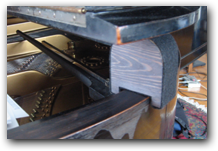
All of this is, of course, speculation. I'd be curious what somebody who really understands acoustics has to say about my findings. Whatever the physics at work, the perceptual difference in the results is hard to deny.
To open the lid this unusually small amount, I use a handy little prop my technician built for me. It's a felt-covered block of wood which sits over the rim — a nice little shop project for recording engineers to consider!